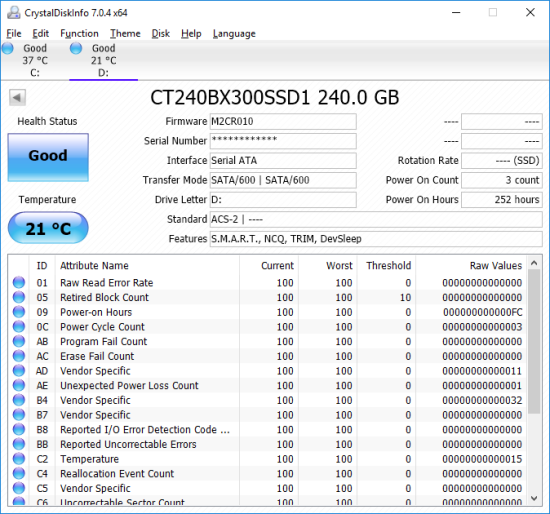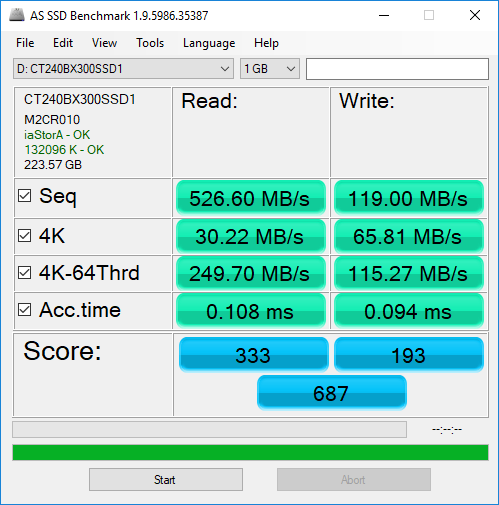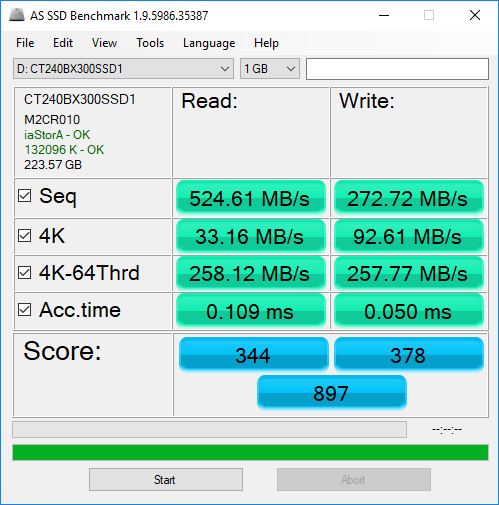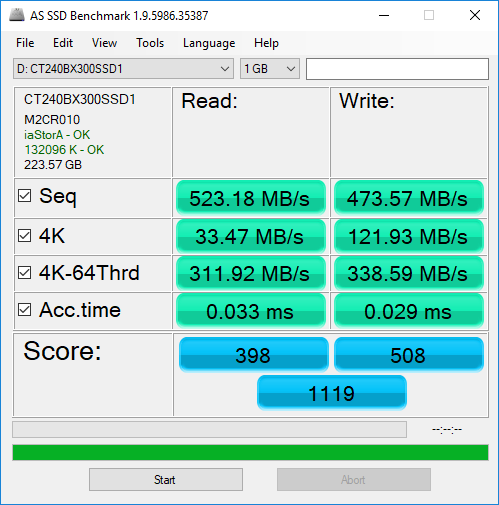TRIM Performance:
While SSD's offer many benefits, there are some downsides to using flash memory. One of the biggest issues people run into is performance degradation. Over time, an SSD will run out of fresh blocks and will have to write over data the file system has marked as deleted. This procedure is very complicated and can slow an SSD's write speeds considerably.
To fix this problem, most manufacturers have added TRIM support to their SSDs. The TRIM command allows an operating system, such as Windows 7, to tell an SSD which data blocks are no longer in use. Using this information, the drive pro-actively erases these blocks and adds them to the free block pool.

To test the BX300's TRIM and garbage collection functions, I first put the drive in a "dirty" state. I used Iometer to fill 80% of the drive and then ran a random write test for 30 minutes. This had little impact on the BX300's read speed. However, its average writing speed dropped to 119.00 MB/s.

Crucial BX300 - Dirty
To see how well the BX300 could recover, I let the computer sit for about 30 minutes and then reran the test. The drive wasn't able to reach the factory fresh performance shown in our earlier tests. However, its average write speed climbed up to 272.72 MB/s.

Crucial BX300 - After TRIM
Lastly, I used Parted Magic to perform a secure erase on the BX300. With the drive wiped clean, it had average read and write speeds of 523.18 MB/s and 473.57 MB/s, respectively.

Crucial BX300 - Secure Erased
Final Thoughts:
Crucial's BX300 SSD is a great choice for the consumer looking for an easy and affordable way to improve the performance of their existing desktop or notebook computer. The drive combines Silicon Motion's SM2258 controller with Micron's 3D MLC NAND to deliver a fast, responsive computing experience at a price that won't break the bank. In our sequential read and write tests, the BX300 was able to read at speeds as high as 561 MB/s and write at speeds in excess of 505 MB/s. It also did very well in our random write tests, producing more than 81,000 IOPS at low queue depths.
With its lower price tag, it shouldn't be too surprising that the BX300's feature set isn't as extensive as Crucial's MX-series SSDs. The drive covers the basics by offering support for thermal monitoring, active garbage collection, TRIM and Device Sleep, but lacks some of Crucial's more advanced technologies like Data Defense and Redundant Array of Independent NAND (RAIN). The BX300 doesn't offer support for hardware based encryption either. This probably won't be an issue for the average consumer. However, if data security is a concern, Crucial's MX300 SSD may be a better choice.
The Crucial BX300 is available now in 120GB, 240GB and 480GB capacities. Prices on Amazon.com currently range from $60 up to $145, with the 240GB version reviewed here retailing for about $88.

Highs:
- Available in 120GB, 240GB and 480GB capacities
- Silicon Motion SM2258 controller
- Micron 3D MLC NAND
- Good sequential and random read and write performance
- Supports TRIM, SMART and active garbage collection
- DEVSLP power mode
- Works with Crucial's Storage Executive software
- Includes 9.5mm spacer and data migration software key
- Affordably priced
- 3 year warranty
Lows:
- Not available in higher capacities
- Does not support hardware based encryption

